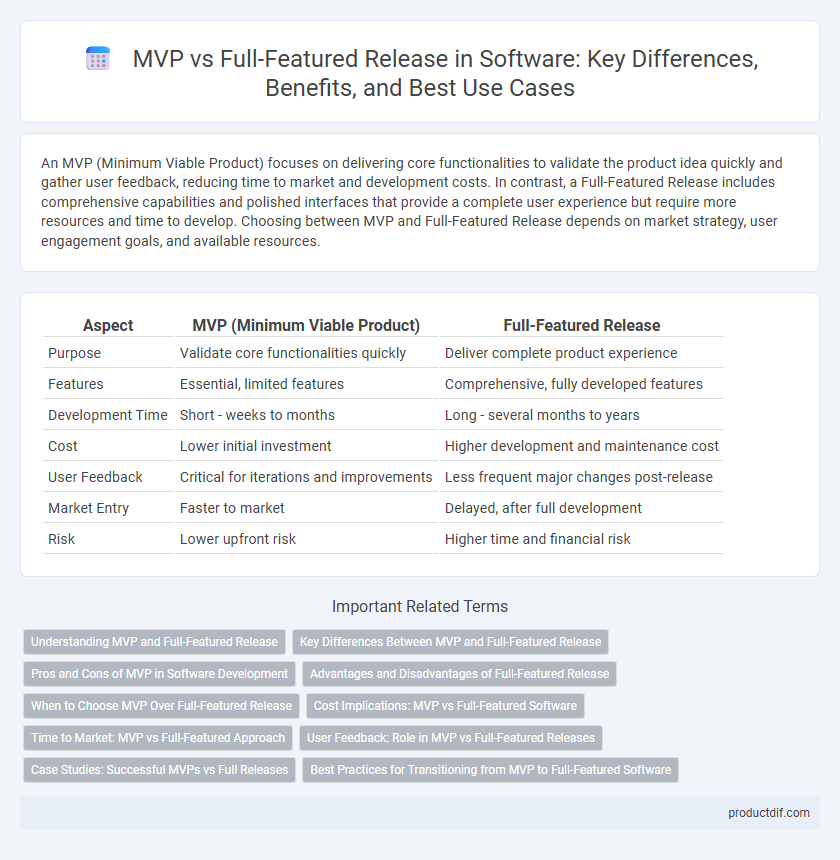An MVP (Minimum Viable Product) focuses on delivering core functionalities to validate the product idea quickly and gather user feedback, reducing time to market and development costs. In contrast, a Full-Featured Release includes comprehensive capabilities and polished interfaces that provide a complete user experience but require more resources and time to develop. Choosing between MVP and Full-Featured Release depends on market strategy, user engagement goals, and available resources.
Table of Comparison
| Aspect | MVP (Minimum Viable Product) | Full-Featured Release |
|---|---|---|
| Purpose | Validate core functionalities quickly | Deliver complete product experience |
| Features | Essential, limited features | Comprehensive, fully developed features |
| Development Time | Short - weeks to months | Long - several months to years |
| Cost | Lower initial investment | Higher development and maintenance cost |
| User Feedback | Critical for iterations and improvements | Less frequent major changes post-release |
| Market Entry | Faster to market | Delayed, after full development |
| Risk | Lower upfront risk | Higher time and financial risk |
Understanding MVP and Full-Featured Release
An MVP (Minimum Viable Product) is a development strategy focused on delivering the core features necessary to solve a specific problem, allowing early user feedback and fast market entry. A full-featured release includes a comprehensive set of functionalities designed to provide a complete user experience, emphasizing scalability, robustness, and polished design. Understanding the differences between MVP and full-featured releases enables teams to optimize resources, validate ideas quickly, and plan more effectively for future development stages.
Key Differences Between MVP and Full-Featured Release
An MVP (Minimum Viable Product) focuses on delivering the core functionalities necessary to validate a product idea and gather user feedback quickly, minimizing development time and resources. In contrast, a full-featured release includes a comprehensive set of features designed to provide a complete user experience and meet broader market demands. The key difference lies in scope and purpose: MVP prioritizes essential features for early validation, while full-featured releases emphasize robustness, scalability, and advanced functionalities.
Pros and Cons of MVP in Software Development
An MVP (Minimum Viable Product) in software development enables rapid market entry and user feedback collection, reducing initial development costs and risks. However, MVPs often lack comprehensive features, which can result in limited user satisfaction and potential misinterpretation of market needs. Balancing speed with usability is crucial to avoid branding issues and ensure scalable product evolution.
Advantages and Disadvantages of Full-Featured Release
A full-featured release provides users with a comprehensive and polished product, enhancing customer satisfaction and competitive positioning by meeting a wide array of needs from the start. Development involves higher initial costs, longer time-to-market, and increased risks of feature bloat or bugs due to complex integrations. Businesses must balance these disadvantages against the advantage of delivering complete functionality that can drive immediate revenue and brand loyalty.
When to Choose MVP Over Full-Featured Release
Choosing an MVP (Minimum Viable Product) over a full-featured release is ideal when validating core hypotheses and gathering user feedback quickly to reduce development risk and costs. MVP allows rapid iteration based on real user data, enabling teams to prioritize essential features and adapt product direction efficiently. Startups and projects in high uncertainty benefit most from MVP to achieve faster time-to-market and resource optimization before scaling up functionality.
Cost Implications: MVP vs Full-Featured Software
Developing a Minimum Viable Product (MVP) significantly reduces initial costs by focusing on essential features, enabling faster market entry and early user feedback. In contrast, a full-featured software release demands higher upfront investment due to comprehensive functionality, extensive testing, and often longer development cycles. Choosing an MVP approach can optimize budget allocation and minimize financial risk while validating product-market fit before scaling.
Time to Market: MVP vs Full-Featured Approach
An MVP (Minimum Viable Product) significantly reduces time to market by delivering essential features that address core user needs, enabling faster user feedback and iterative development. In contrast, a full-featured release requires extensive development and testing, delaying launch but providing a comprehensive product experience. Prioritizing MVP accelerates market entry, which is crucial for competitive advantage and validating product-market fit early.
User Feedback: Role in MVP vs Full-Featured Releases
User feedback plays a critical role in MVP development by guiding iterative improvements and validating core functionalities with early adopters. In full-featured releases, user feedback informs the refinement of advanced features and enhances overall user experience based on broader usage data. Continuous feedback loops help align the product with market needs throughout both stages.
Case Studies: Successful MVPs vs Full Releases
Case studies of successful MVPs, such as Dropbox and Airbnb, demonstrate rapid market entry and user feedback-driven iterations that effectively shape product development. In contrast, full-featured releases like Microsoft Office's initial launch emphasize comprehensive functionality but often face higher development costs and longer time-to-market. Analyzing these examples reveals that MVPs accelerate validation and reduce risk, while full releases cater to complete user needs from the outset.
Best Practices for Transitioning from MVP to Full-Featured Software
Successful transition from MVP to full-featured software involves iterative user feedback integration to refine core functionalities and prioritize feature development based on actual user needs. Employing scalable architecture and modular design patterns ensures seamless incorporation of new features without compromising system stability. Implement robust testing protocols and continuous deployment pipelines to maintain software quality throughout each upgrade cycle.
MVP vs Full-Featured Release Infographic

 productdif.com
productdif.com